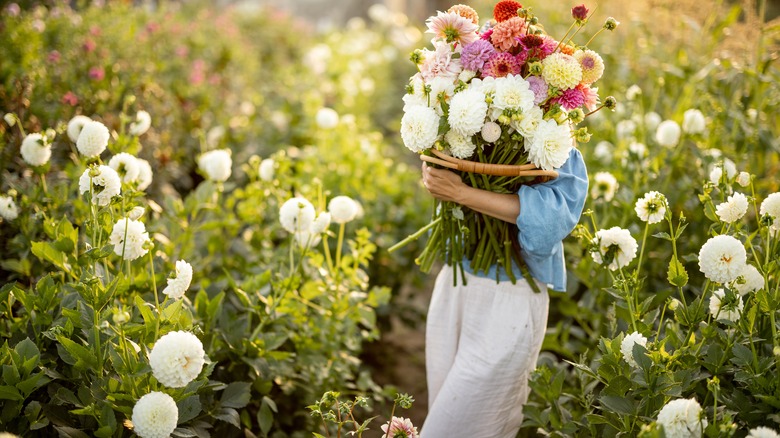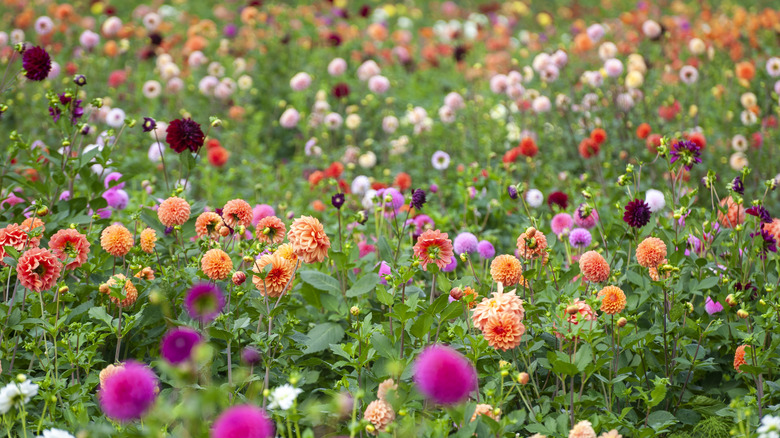The Stunning Garden Flower That Looks Like It Is Straight Out Of The Lorax
Dr. Seuss's story, "The Lorax," has been a hit with gardeners and plant lovers since it was published in 1971. Between its message of environmental conservation and the charming illustrations, what's not to love? If you too want to channel the whimsy of Dr. Seuss's drawings in your garden design, consider growing stunning 'Bloomquist Jean' dahlias that resemble the Lorax's beloved truffula trees.
Of course, despite their visual similarities, 'Bloomquist Jean' dahlias aren't actually trees, truffula, or otherwise. They're dahlias (Dahlia spp.); the beloved flowers that come in an almost unbelievable range of colors, shapes, and sizes. 'Bloomquist Jean' dahlias, with their strange hair-like petals and flower size of around 6 inches, are considered a type of informal decorative dahlia. To grow your own 'Bloomquist Jean' dahlia be sure to purchase the plant as a tuber, as that ensures it is the right cultivar. Thanks to the dahlia's complex genetics, dahlias grown from seeds, while beautiful, are unpredictable in their shapes and forms and won't perfectly resemble their parents.
Growing 'Bloomquist Jean' dahlias
Native to Mexico, South, and Central America, dahlias are hardy in zones 7 through 10, simply dying back to their tubers during the cold months and reemerging each spring once the ground warms. Fortunately, even if you garden in a colder zone, you don't have to give up on dahlias. Instead, just dig and store the tubers to protect your dahlias from the cold winter weather and then replant them outside a week or two before your last frost. Be sure to plant your dahlias in a sunny spot with fertile and well-draining soil. As 'Bloomquist Jean' is a taller variety, reaching about 4 feet, opt to plant the tubers about 6 inches deep. (Shorter dahlia varieties are often planted more shallowly.) Be sure to test the health of your soil to see if your dahlias would benefit from fertilizer before adding anything, as dahlias can suffer from over-fertilizing.
Dahlias need regular water, but their tubers are also prone to rotting, so one popular recommendation is to avoid watering until the plants have grown to about 4 inches tall. Once your plants are thriving, you can water them deeply about once a week. Taller dahlia varieties like 'Bloomquist Jean' often require staking, so be sure to provide your plant with the necessary support. You may also want to pinch your dahlias to encourage branching, and don't forget to deadhead to encourage them to keep blooming all season.
Using 'Bloomquist Jean' dahlias in the garden
You can't beat 'Bloomquist Jean' dahlias for whimsy in the garden, but a few flowers can match them. If you want to lean into the strange and surreal Seussian garden design, consider pairing your 'Bloomquist Jean' dahlias with other equally distinctive-looking flowers like ball and pompon style dahlias. Ornamental allium plants also grow in similar conditions to dahlias and would make excellent companions in your strange Lorax-inspired garden.
Many varieties of ornamental alliums and pompon dahlias don't grow past 2 or 3 feet, making them ideal for placing towards the front of beds, with the larger 'Bloomquist Jean' behind them. Poker plants (Kniphofia spp.) are another plant with strong Seussian vibes to consider adding to your truffula forest, and with their height ranging from less than 2 feet to well over 6 feet, you're sure to find a variety that fits in perfectly. Of course, if you're looking for unconventional flowers, you can't forget to include some crested celosia (Celosia argentea) as well. With many varieties coming in at less than a foot tall, they're the perfect choice for the front of the border or Seussian bedding plants.

